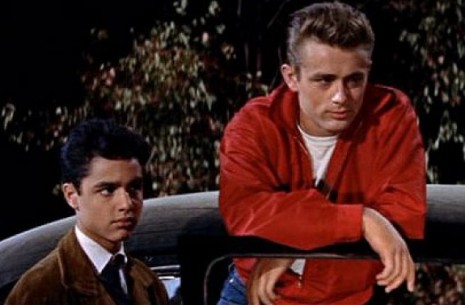 Today we’ll explore the influence, look, and emerging technology of the pervasive medium of television in the 1950s. We will likely screen and discuss a number of short clips from this list and you might enjoy checking out the rest on your own:
Today we’ll explore the influence, look, and emerging technology of the pervasive medium of television in the 1950s. We will likely screen and discuss a number of short clips from this list and you might enjoy checking out the rest on your own:
“Leave it To Beaver,” starring the iconic & perfect Cleaver family: the wise parents Ward & June, and the earnest good sons, Wally & “the Beaver” (9:46)
“Somewhere That’s Green,” sung by Ellen Greene, from the feature film musical Little Shop of Horrors (1986), a nostalgic 1980s tribute to sci-fi films of the 1950s; in this scene the main character Audrey (a battered floozy) imagines leaving the dismal city and moving to the suburbs to live a Levittown American Dream as a June-Cleaver-esque housewife. (4:25)
Popular kids shows of the 1950s included Westerns like “The Lone Ranger,” a masked man and his faithful (nonwhite) sidekick fight crime & Indians in the Old West. (2:49)
Other popular children’s programs included Howdy Doody, and Lassie.
“Two Ford Freedom” – a 1950s filmed commercial for Ford, in which a housewife explains the ease and benefits of owning a second car. (1:39)
Undated commercial for Brylcreem, a men’s hair product – showing the use of catchy musical jingles in this era. (1:00)
The fabulous, glamorous, ultra-feminine TV star Dinah Shore pitches for Chevrolet (her show’s sponsor) in this 1952 commercial, “See the USA in Your Chevrolet,” that not only advertises the new model of car, but also the gleaming new interstate highway system just being dreamed & built in the 1950s. (1:33)
Speaking of women on television, this unusual game show/ reality show had women competing for the honor of being “Queen for a Day” based on who had the worst, most depressing and most pathetic life. It’s a fascinating look at America’s underclass, argues one scholar, in years when everyone on TV seemed to be white and wealthy. This particular clip also contains a commercial for “Rinso” and was filmed in Kinescope from a live broadcast. (2:49)
Another classic sitcom of the 1950s, “http://www.youtube.com/watch?v=ScLNAVwmjgQ“>I Love Lucy,” which was innovatively filmed in Hollywood rather than sent out live from New York–which meant it has been successfully syndicated on TV ever since. In this episode, Lucy has tried to raise eggs, and is incubating them inside her blouse. (4:49)
One unusual TV star of this era was a Catholic bishop from New York named Fulton J. Sheen, whose program, “Life is Worth Living” was a huge surprise hit on Sunday evenings. His “chalk talks” and sermons attracted Protestants and Catholics alike with his easy wit, self-deprecating humor and grand religious regalia. In this clip (filmed before a live studio audience), Sheen rails against godless Communism. (2:51).
Before TV went west to Hollywood, anthology drama series modified Broadway-type plays for the small screen. A classic of this genre, filmed live, was 1953 Philco Playhouse’s “Marty,” about a lonely young working man looking for love in a New York City dance hall. (Part 1 of 4)
Talk about a pop-culture mashup: Elvis Presley and Debra Paget on the Milton Berle Show in 1956 – a prime-time variety show which bridged to the old early 20th century live vaudeville entertainment and was a something of a forerunner to the Tonight Show and SNL. (2:32)
“I Led Three Lives” was a drama series based on the life of Herbert Philbrick, an FBI agent charged with infiltrating Communist subversive cells–with plots seemingly ripped straight from McCarthy’s Senate committee hearings. Two episodes here: “Radioactive” and “Army Infiltration.”
By the end of the decade, Chairman of the FCC Newton Minow thought TV was a “vast wasteland” and he said so in a speech to the National Association of Broadcasters on 9 May 1961. Audio and transcript of the speech are here – you may be impressed at how relevant his criticisms still are.
For other vintage TV clips, try these sources:
Internet Archive
Retro Youtube
Paley Center for Media (formerly Museum of Television and Radio in NYC)
TV4U
OldiesTelevision
KineVideo (no online streaming, though)







